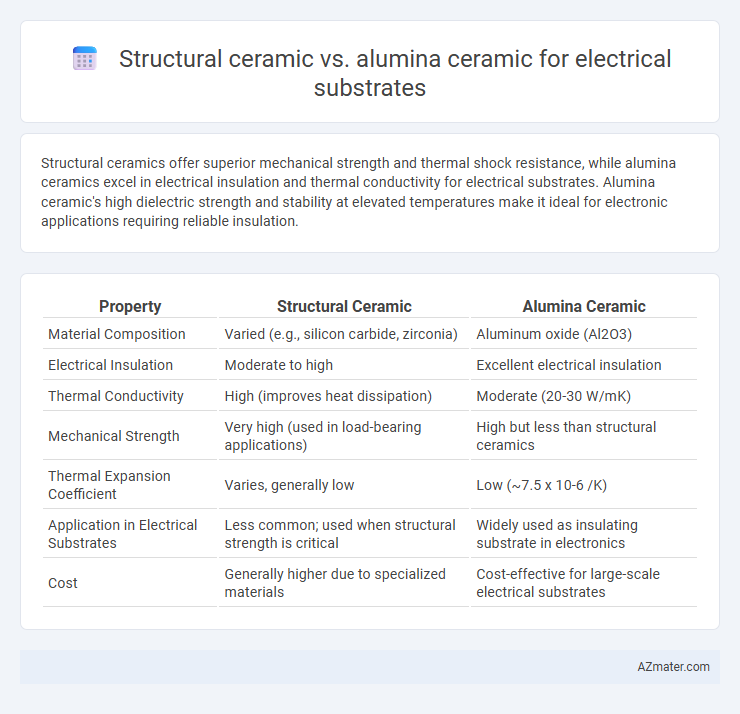Structural ceramics offer superior mechanical strength and thermal shock resistance, while alumina ceramics excel in electrical insulation and thermal conductivity for electrical substrates. Alumina ceramic's high dielectric strength and stability at elevated temperatures make it ideal for electronic applications requiring reliable insulation.
Table of Comparison
| Property | Structural Ceramic | Alumina Ceramic |
|---|---|---|
| Material Composition | Varied (e.g., silicon carbide, zirconia) | Aluminum oxide (Al2O3) |
| Electrical Insulation | Moderate to high | Excellent electrical insulation |
| Thermal Conductivity | High (improves heat dissipation) | Moderate (20-30 W/mK) |
| Mechanical Strength | Very high (used in load-bearing applications) | High but less than structural ceramics |
| Thermal Expansion Coefficient | Varies, generally low | Low (~7.5 x 10-6 /K) |
| Application in Electrical Substrates | Less common; used when structural strength is critical | Widely used as insulating substrate in electronics |
| Cost | Generally higher due to specialized materials | Cost-effective for large-scale electrical substrates |
Introduction to Structural Ceramics and Alumina Ceramics
Structural ceramics are engineered materials known for their superior mechanical strength, high-temperature stability, and excellent wear resistance, making them ideal for load-bearing applications. Alumina ceramics, a subset of structural ceramics, are widely used for electrical substrates due to their exceptional dielectric properties, high thermal conductivity, and chemical inertness. These characteristics enable alumina ceramics to provide reliable insulation and heat dissipation in electronic components, outperforming many other structural ceramic materials in electrical applications.
Key Material Properties Comparison
Structural ceramics excel in mechanical strength and thermal stability but often have lower electrical insulation compared to alumina ceramics. Alumina ceramics offer superior dielectric strength, high thermal conductivity, and excellent electrical insulation, making them ideal for electrical substrates. Key properties such as high hardness, low dielectric constant, and resistance to thermal shock distinguish alumina ceramic as the preferred choice in electronic component applications.
Electrical Performance: Dielectric Strength and Insulation
Structural ceramics generally offer higher mechanical strength but lower dielectric strength compared to alumina ceramics, which excel in electrical insulation properties. Alumina ceramic substrates typically provide dielectric strength values ranging from 10 to 15 kV/mm, ensuring superior insulation for high-voltage applications. The lower dielectric constant and high resistivity of alumina make it preferable for electrical substrates requiring minimal signal loss and enhanced thermal conductivity.
Mechanical Strength and Durability
Structural ceramics exhibit superior mechanical strength and durability compared to alumina ceramics when used as electrical substrates, primarily due to their enhanced fracture toughness and resistance to wear. Alumina ceramics, while providing excellent electrical insulation and thermal stability, often possess lower mechanical strength and are more brittle under mechanical stress. The choice between these materials depends on the application's demand for toughness versus thermal and electrical performance, with structural ceramics favoring high-impact and high-load environments.
Thermal Conductivity and Heat Resistance
Alumina ceramic offers superior thermal conductivity, typically around 20-30 W/m*K, compared to many structural ceramics, making it highly efficient for electrical substrates requiring effective heat dissipation. Its excellent heat resistance allows operation at temperatures up to 1700degC, outperforming many structural ceramics that generally withstand lower maximum temperatures. The combination of high thermal conductivity and heat resistance makes alumina ceramic ideal for applications in power electronics and high-temperature environments.
Manufacturing Processes and Design Flexibility
Structural ceramics typically involve processes like sintering and hot pressing to achieve high mechanical strength and thermal stability, making them suitable for robust electrical substrates. Alumina ceramic, renowned for its excellent electrical insulation and thermal conductivity, is manufactured through precise tape casting and screen printing techniques, allowing fine control over thickness and electrode patterns. Design flexibility in alumina ceramics is enhanced by their compatibility with multilayer configurations and intricate metallization, while structural ceramics offer more limited adaptability due to their dense microstructure and conventional shaping methods.
Cost Analysis and Economic Considerations
Structural ceramics typically exhibit higher raw material and processing costs compared to alumina ceramics, primarily due to advanced fabrication techniques and superior mechanical properties. Alumina ceramic remains the preferred choice for electrical substrates in cost-sensitive applications, offering a balance of electrical insulation, thermal conductivity, and affordable manufacturing. Economic considerations favor alumina ceramics when volume production and overall cost-efficiency are prioritized, while structural ceramics suit specialized applications demanding enhanced durability despite increased expenses.
Typical Applications in Electrical Substrates
Structural ceramics like silicon nitride and zirconia are utilized in high-stress electrical substrates due to their superior mechanical strength and fracture toughness, making them ideal for applications in power electronics and high-frequency devices. Alumina ceramic remains the industry standard for electrical substrates because of its excellent dielectric properties, thermal conductivity, and cost-effectiveness, commonly used in LED substrates, circuit boards, and insulation layers. Both materials provide electrical insulation and thermal management, but alumina's balance of performance and affordability dominates typical applications in consumer electronics and automotive sensors.
Lifespan and Reliability in Electronic Devices
Structural ceramics and alumina ceramics both serve as electrical substrates, but alumina ceramic offers superior lifespan and reliability in electronic devices due to its excellent thermal conductivity and electrical insulation properties. Alumina ceramics resist thermal cycling and mechanical stress better than typical structural ceramics, resulting in longer service life and consistent performance. The high purity and stability of alumina minimize defects and failure rates, making it the preferred choice for demanding electronic applications requiring durability.
Choosing the Right Ceramic: Structural vs Alumina
Alumina ceramic offers superior electrical insulation and high thermal conductivity, making it ideal for electrical substrate applications requiring efficient heat dissipation and dielectric strength. Structural ceramics provide enhanced mechanical strength and fracture toughness, suitable for environments with significant mechanical stress or impact. Selecting between structural and alumina ceramic depends on balancing electrical performance needs with mechanical durability in the substrate design.

Infographic: Structural ceramic vs Alumina ceramic for Electrical substrate
 azmater.com
azmater.com